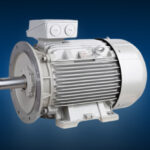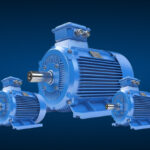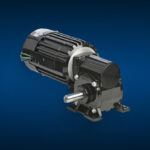Engineers & plant managers often have to make tough choices when selecting motors for heavy-duty applications. A simple squirrel cage induction motor is a good pick because of its low maintenance and strong performance under load.
This article describes 3 phase squirrel cage induction motor, its construction, key advantages and real-life applications in factories and processing plants. Fresh market data will show you why the 3 phase squirrel cage induction motor dominates industrial drives and help you make smarter equipment decisions for reliable operations.
Overview: Squirrel Cage Induction Motor
- Core Design: Squirrel cage induction motor has a three-phase stator and conductive bars with end rings short-circuited for self-starting with no external power source.
- Key Benefits: Robust build, low maintenance, high efficiency up to IE4 motor standards and low cost make it suitable for constant speed industrial applications.
- Common Uses: Power pumps, fans, conveyors and compressors in manufacturing, oil refineries and water treatment facilities.
- Efficiency Edge: Reduces energy use by 5-10% over older models in line with 2025 sustainability goals.
What Is Squirrel Cage Induction Motor?
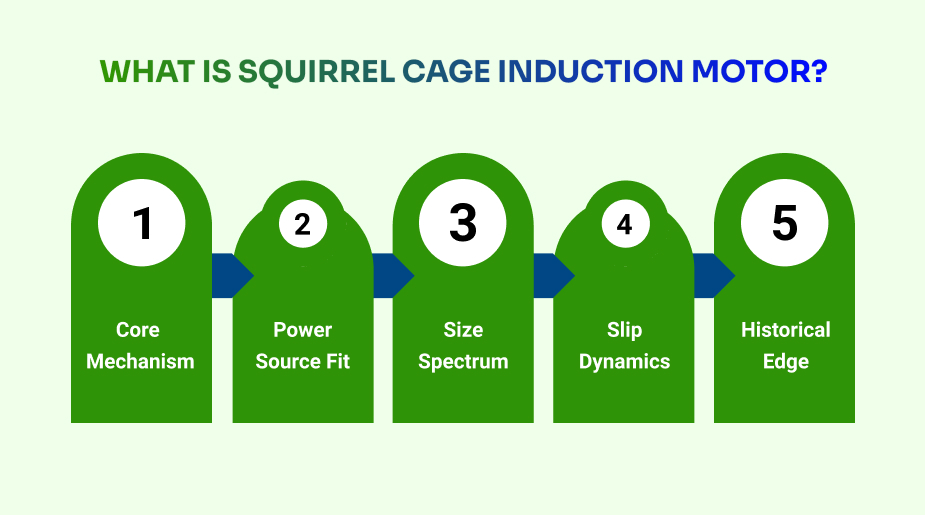
Engineers first witnessed a squirrel cage induction motor more than a century ago when Nikola Tesla designed factories with AC power.
Today it drives assembly lines to ventilation systems and is prized for converting electrical input into mechanical output without an extra starting gear.
This motor type does away with wound rotors and relies on induction alone to spin – a common setup where simplicity meets tough lifting.
- Core Mechanism: It uses a rotating magnetic field from the stator to induce current in the rotor bars without electrical connections to the spinning part.
- Power Source Fit: Draws from standard three phase ac supplies at 50/60 Hz, which can be matched with grid power in almost all plants.
- Size Spectrum: Scales from fractional horsepower light fans to 500 kW giant mill drives without redesigns.
- Slip Dynamics: Operates at 2-5% under synchronous speed, with natural overload protection when torque increases with small speed dips.
- Historical Edge: Holding 80% of induction motor installs worldwide and evolving back from early 1890s prototypes.
Squirrel Cage Induction Motor Construction
Squirrel cage induction motor construction requires precision for factory grit & heat cycles. The builders stacked thin silicon steel laminations for the stator core to minimize magnetic losses that would drain power.
A die-cast rotor or copper – shaped bar forms those signature bars uniform and unbreakable, and the outer frame seals it all in ventilated castings. This layered approach helps the motor resist vibrations and dust for decades of real-world grind.
- Stator Assembly: Three-phase windings housed in slots, offset for balanced fields; Using Class F insulation to cope with 155°C peaks without breakdown.
- Rotor Bars and Rings: Axiomatic bars 20-60 per lamination stack; end rings shorted by; deep-bar designs add 20% more starting torque at high inertia start.
- Bearing Supports: At shaft ends, ball or roller types, greased for life/oil lubricated rated for 100,000 + hours B10 life at full load.
- Enclosure Variants: Totally enclosed fan cooled (TEFC) on dusty sites or open drip-proof on cleaner air flows, all IP55 sealed.
- Shaft and Keyway: Machined steel shafts coupled with feather keys; coatings with corrosion resistance provide service in humid or chemical zones.
How a Three Phase Squirrel Cage Induction Motor Works
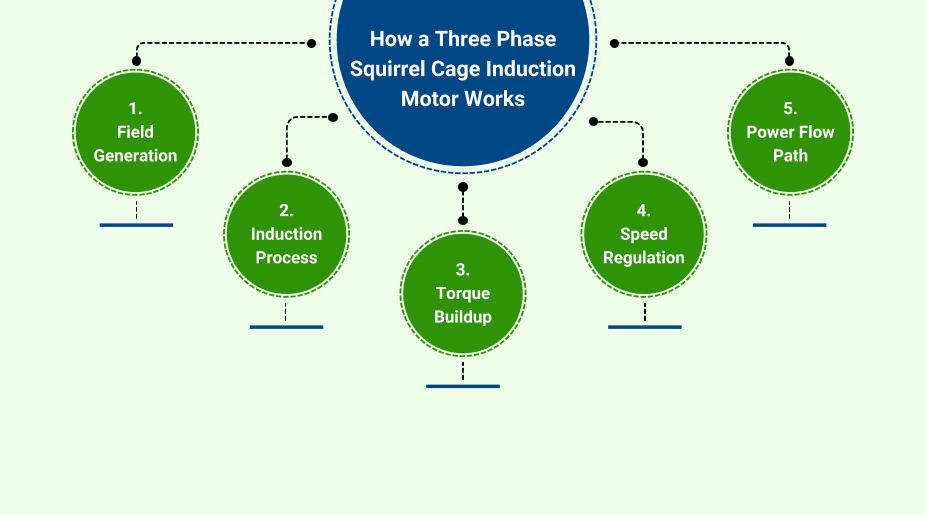
Flip a switch on a squirrel cage induction motor and three currents phase shift to produce a magnetic wave in a stator. This field pulls the rotor along and creates currents that create opposing forces with pure physics turning amps into action.
Speed stabilises around the field pace, and torque peaks early to haul loads from standstill. No commutators or exciters make things more complicated. It’s all an induction motor tuned for production hum.
- Field Generation: Stator coils energize sequentially creating 120° phase lags; 50 Hz/four poles synchronous speed clock at 1500 RPM.
- Induction Process: Rotor bars slice flux lines, causing voltage via Lenz’s law. Circumferential currents flow 90° behind the stator’s rotor field.
- Torque Buildup: Starts at 150-250% full load value, then drops to a stable curve; double-cage rotor layer bars for quick acceleration without surges.
- Speed Regulation: Natural slip absorbs load changes. Put weight on a fan, RPM drops 1-2% whereas torque climbs to match.
- Power Flow Path: Split input to stator losses of 5-10%, rotor I²R heat of 3-5%, and mechanical output; Under load, PF is between 0.82-0.88.
Why Squirrel Cage Induction Motors Excel in Industrial Drives
The squirrel cage induction motor for drives is a tried and true product that works hard under the roar of machinery and the high demand of plant operators. Its brushless guts evade carbon dust and arcing of alternatives, and inherent slip forgives jams without fusing breakers.
In 2025’s quest for lean operations, these motors trim energy tabs & service calls so teams can focus on output, not fixes.
- Rugged Durability: 10g vibrations and 50°C ambients resist; cast rotors crack less under cyclic loads than wound types by 25%.
- Cost Efficiency: Upfront prices 30% below synchronous rivals; lifecycle savings reach 15% with 90% + efficiencies in IE3 models.
- Low Upkeep Demands: No slip-ring brushes or external resistors; annual checks suffice, labor cut by 50% per the 2025 IEC benchmark.
- Torque Reliability: Delivers 200% starting pull for compressors; Increasing load capacity to 150% for 2 hours prevents nuisance trips.
- Safety Compliance: ATEX-rated explosion-proof shells for Zone 1; thermal protectors include PTC sensors halting at 140°C windings.
Application of Squirrel Cage Induction Motor

In busy refineries or clattering workshops the squirrel cage induction motor is applied for jobs that require uncompromising motion. A 75 kW unit can pound a ball mill drum for hours without speed lags and smaller 5 kW versions bring life into exhaust blowers.
Their plug-and-play nature makes them suitable for retrofits as well, as they can be easily swapped into legacy gear for flow control or material shift gains. They anchor processes where failure is unavoidable, from urban water plant hulls to offshore rigs.
- Centrifugal Pumping: At 2900 RPM the drive makes the impeller spins for 200 m heads; common in irrigation/coolant loops; boosts throughput by 15%.
- Conveyor Systems: Power belt drags at 1-2 m/s; variable-pitch sheaves without stalls tune for aggregate or parcel handling.
- Fan and Blower Ops: Air moved by axial units moves 50,000 m³/h air in HVAC. TEFC housings suit foundry fumes and maintain 95% flow under dust buildup.
- Crusher and Mill Drives: 150 kW models drive through rock jams; double-cage starts ease 300% inrush for jaw crushers.
- Elevator and Crane Lifts: Hoist-duty versions with brakes accept 5-ton loads; regen braking stores energy on descents and saves 20% power.
Shrirang Enterprise: Your Source for Reliable Industrial Motors

This blog explains squirrel cage induction motor design & operation and why it dominates modern industrial drives & has unmatched reliability & performance. The 3-phase squirrel cage induction motor continues to remain the industry standard with smart sensing technologies enabling higher efficiency and precision without adding unnecessary cost.
Shri Rang Energy Efficient powers industries since 2005 with Bharat Bijlee high-performance motors built for harsh environments in Ahmedabad and beyond. Need a dust-proof motor or one that produces consistent torque under heavy loads?
Our team will supply it quickly, install it easily and support you at every step. Find the right squirrel cage induction motor for your operation built for durability, efficiency & lasting performance.
Connect with Shrirang Enterprise to source, install, and optimise your next industrial drive.
Frequently asked questions (FAQs)
Q1. Why are squirrel cage induction motors preferred for industrial drives?
A. Squirrel cage induction motors are preferred for their durability, low maintenance, high efficiency, and ability to perform under heavy industrial loads.
Q2. How does a three-phase squirrel cage induction motor work?
A. It operates using a rotating magnetic field in the stator, inducing current in the rotor bars to generate torque without brushes or external excitation.
Q3. What are the advantages of using a squirrel cage induction motor?
A. Key benefits include simple design, cost-effectiveness, long life, low maintenance, and reliable torque for continuous-duty operations in industries.
Q4. Where are squirrel cage induction motors commonly used?
A. They power fans, pumps, conveyors, compressors, and mills in sectors like manufacturing, refineries, water treatment, and HVAC applications.
Q5. How do squirrel cage induction motors improve energy efficiency?
A. Modern designs achieve IE3–IE4 efficiency standards, reducing power consumption by up to 10% compared to older models, supporting sustainability goals.
